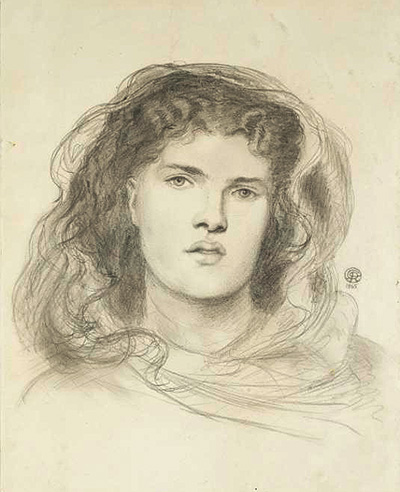Dante Gabriel Rossetti produced a large number of drawings in his career and this section provides a summary of his work in this respected medium.
The majority of his detailed drawings were portraits of his favoured muses. His ability in portraiture was down to a combination of natural talent and sheer hard work and practice. This complex genre never allows for shortcuts and the medium of drawing gives an artist even less room to disguise shortcomings. Many made use of a single colour of pencil on paper, in a similar way to the facial portrait drawings of Waterhouse. There are some examples of where he went into much more complex compositions, though.
Rossetti's more colourful drawings were normally produced in chalk and were left far more complete than his pencil drawings which tended to focus more on line than shaded fills. It is probable that in preparation for a completed oil painting he would produce first the pencil work then the chalk, then finally the multi layered oil painting. This would enable Rossetti to make most amendments prior to starting the main piece. This is a practice used by most famous artists, ever since the early Renaissance.
Two of the more notable series of drawings from this artist were firstly a set of studies that he produced of his wife, Elizabeth, just before they were to be married. Another series of sketches was of Jane Morris, another highly significant woman in his life. When you peruse his overall collection of drawings, you will quickly be able to see which ones fit together into clear series of work, where as others are entirely independant pieces, though normally still linked to a later painting. Indeed most of the earliest work recovered from Rossetti's career was completed in this medium, as he developed his base skills as an artist and wisely sought to avoid running before he could walk. His own mother dated an early piece of his, named The Rocking Horse, as from 1834, when he would have been around just six years old. Many others have been uncovered from his years just before becoming a teenager, most of which are relatively simple drawings.
Rossetti would enter the Royal Academy in 1845 after a spell at Sass's Academy. He found himself some what uncomfortable by the academic style of teaching here, however, and eventually sought out the experienced British painter, Ford Madox Brown, to take him under his wing, which he agreed to do. From then on he would concentrate more on paintings with oils but his drawings remained a fundamental part of his artistic process and its importance to him was never downplayed. The restless artist would then switch allegiance to the young artist, William Holman Hunt, for a new stint of discovery and learning. Despite his erratic loyalties, the group of the Pre-Raphaelite Brotherhood would emerge from this connection of artists and build a highly successful legacy.




